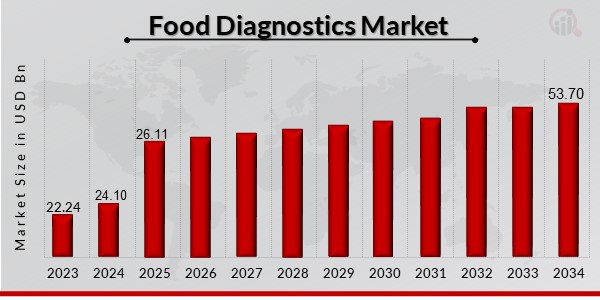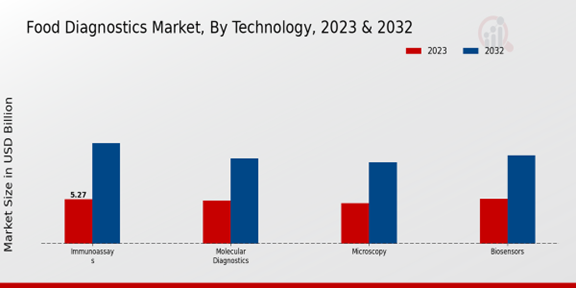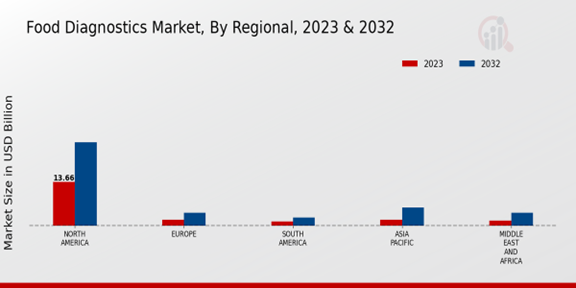Global Food Diagnostics Market Overview
Food Diagnostics Market Size was estimated at 24.10 (USD Billion) in 2024. The Food Diagnostics Industry is expected to grow from 26.11 (USD Billion) in 2025 to 53.70 (USD Billion) by 2034. The Food Diagnostics Market CAGR (growth rate) is expected to be around 8.3% during the forecast period (2025 - 2034).

Source: Primary Research, Secondary Research, MRFR Database and Analyst Review
Key Food Diagnostics Market Trends Highlighted
Key market drivers in the Food Diagnostics Market include the rising demand for food safety, increasing consumer awareness about foodborne diseases, and stringent government regulations to ensure food quality and safety. Technological advancements, such as the development of rapid diagnostic tests and biosensors, are also driving market growth.
Opportunities for market expansion lie in the exploration of new technologies like rapid multiplexing, the development of portable devices, and advancements in diagnostic assay techniques. The market is expected to witness a shift towards preventive and proactive approaches to food safety, with a focus on early detection and rapid response to foodborne outbreaks.
Recent trends in the Food Diagnostics Market include the growing adoption of automation and artificial intelligence in diagnostic systems to improve accuracy and efficiency. There is also a shift towards point-of-care testing for quick and reliable food safety monitoring. The demand for rapid and accurate diagnostic tests for foodborne pathogens, such as Salmonella, E. coli, and Listeria, is expected to remain strong in the coming years.
Food Diagnostics Market Drivers
Rising Incidence of Foodborne Illnesses
The increasing prevalence of foodborne illnesses is a major concern for consumers and the food industry alike. According to the World Health Organization (WHO), an estimated 600 million people worldwide fall ill from foodborne diseases each year, resulting in 420,000 deaths. This has led to a growing demand for food diagnostics to ensure the safety of the food supply and protect consumers from harmful pathogens. Food diagnostics play a crucial role in detecting and identifying pathogens in food products, enabling timely intervention and preventing outbreaks of foodborne illnesses.
Advancements in Food Diagnostics Technology
Technological advancements are continuously improving the accuracy, speed, and affordability of food diagnostics. The development of rapid diagnostic tests, such as biosensors and molecular diagnostics, has significantly reduced the time required to detect pathogens in food products. These tests can provide results within minutes or hours, allowing for faster decision-making and more effective responses to food safety concerns. Additionally, the increasing availability of portable and user-friendly diagnostic devices has made food diagnostics more accessible and convenient for various stakeholders in the food industry.
Stringent Food Safety Regulations
Governments worldwide are implementing stricter food safety regulations to ensure the quality and safety of food products. These regulations often mandate the use of food diagnostics to verify compliance with safety standards. For instance, the Food Safety Modernization Act (FSMA) in the United States requires food manufacturers to implement preventive controls and conduct regular testing to ensure the safety of their products. This has led to a significant increase in the demand for food diagnostics services to meet regulatory requirements and maintain consumer confidence in the food supply.
Food Diagnostics Market Segment Insights
Food Diagnostics Market Technology Insights
The Food Diagnostics Market is segmented into various technologies, including Immunoassays, Molecular Diagnostics, Microscopy, and Biosensors. Each technology offers unique advantages and applications in the food diagnostics industry. Immunoassays accounted for the largest share of the Food Diagnostics Market in 2023 and are expected to maintain their dominance throughout the forecast period. Immunoassays are widely used for detecting foodborne pathogens, allergens, and toxins. They offer high specificity and sensitivity, making them a preferred choice for food safety testing.
For instance, in 2023, the global market for immunoassays in food diagnostics was valued at USD 6.5 billion and is projected to reach USD 10.2 billion by 2032. Molecular Diagnostics is another rapidly growing segment in the Food Diagnostics Market. Molecular Diagnostics methods like PCR (Polymerase Chain Reaction) and DNA sequencing are employed for the identification and characterization of microorganisms in food products. The increasing demand for accurate and rapid detection of foodborne pathogens is driving the growth of this segment.
In 2023, the molecular diagnostics segment was valued at USD 4.2 billion and is projected to reach USD 7.8 billion by 2032. Microscopy is a traditional technology used in food diagnostics for the examination of microorganisms, foodborne pathogens, and other contaminants. Microscopy offers the advantage of direct visualization and allows for morphological characterization. However, it requires trained personnel and can be time-consuming. Biosensors are gaining traction in the Food Diagnostics Market due to their ability to provide real-time and on-site detection of foodborne pathogens and contaminants.
Biosensors are small, portable devices that utilize biological recognition elements to detect specific target analytes. The growing need for rapid and cost-effective food safety testing is the adoption of biosensors in the market.

Source: Primary Research, Secondary Research, MRFR Database and Analyst Review
Food Diagnostics Market End Use Insights
The Food Diagnostics Market is segmented based on End Use into Food Safety and Quality Control, Allergen Detection, Microbial Analysis, Pathogen Detection, and Veterinary Diagnostics. Among these segments, Food Safety and Quality Control held the largest market share in 2023, accounting for over 40% of the global revenue. This dominance is attributed to the increasing demand for food safety and quality assurance to prevent foodborne illnesses and protect consumer health. The Allergen Detection segment is projected to witness the highest CAGR during the forecast period, driven by the rising prevalence of food allergies and the growing need for accurate and rapid allergen testing.
Microbial Analysis and Pathogen Detection segments are also expected to experience significant growth due to the increasing incidence of foodborne diseases and the need for effective pathogen identification and control. The Veterinary Diagnostics segment is witnessing growing adoption in the animal health industry for disease diagnosis, monitoring, and control, contributing to its market growth.
Food Diagnostics Market Sample Type Insights
The Food Diagnostics Market is segmented by Sample Type into Food Products, Food Ingredients, and Environmental Samples. The Food Products segment held the largest market share in 2023 and is expected to maintain its dominance throughout the forecast period. The growth of this segment can be attributed to the increasing demand for food safety testing to ensure the quality and safety of food products. The Food Ingredients segment is also expected to witness significant growth due to the rising demand for food ingredients testing to ensure their quality and compliance with regulatory standards.
The Environmental Samples segment is expected to grow at a steady pace, driven by the increasing awareness of the importance of environmental monitoring to ensure food safety and quality.
Food Diagnostics Market Regional Insights
The Food Diagnostics Market is segmented into North America, Europe, APAC, South America, and MEA. Among these regions, North America and Europe collectively accounted for over 60% of the Food Diagnostics Market revenue in 2023, owing to the high prevalence of foodborne illnesses, stringent regulatory frameworks, and advanced healthcare infrastructure in these regions. APAC is expected to witness the highest growth rate during the forecast period due to the increasing population, rising disposable income, and growing awareness about food safety in the region.
South America and MEA are expected to have a steady growth rate, driven by the increasing demand for food diagnostics in these regions.

Source: Primary Research, Secondary Research, MRFR Database and Analyst Review
Food Diagnostics Market Key Players and Competitive Insights
Major players in the Food Diagnostics Market seek competitive advantages through strategic partnerships, acquisitions, and new product launches. To strengthen their market position and expand their product offerings, leading Food Diagnostics Market players are actively involved in collaborations and partnerships with other industry stakeholders, including research institutions, diagnostic laboratories, and technology providers. Companies are also pursuing acquisitions to gain access to new technologies, expand their geographical reach, and strengthen their product portfolios. New product launches are another key competitive strategy employed by Food Diagnostics Market players to cater to the evolving needs of the market and gain market share
One of the prominent competitors in the Food Diagnostics Market is Bio-Rad Laboratories, Inc. The company offers a diverse portfolio of food safety testing products, including rapid tests, immunoassays, and molecular diagnostics. Bio-Rad Laboratories, Inc. has a strong global presence and a well-established distribution network. The company's commitment to research and development enables it to continuously introduce innovative products and solutions to meet the changing demands of the food industry.
Another key competitor in the Food Diagnostics Market is Thermo Fisher Scientific Inc. The company offers a comprehensive range of food testing solutions, including rapid pathogen detection kits, automated systems, and quality control reagents. Thermo Fisher Scientific Inc. has a global reach and a wide customer base in the food and beverage industry. The company's commitment to quality and compliance has earned it a strong reputation among customers.
Key Companies in the Food Diagnostics Market Include
- Danaher Corporation
- Merck KGaA
- RBiopharm AG
- QIAGEN
- Sysmex Corporation
- Lonza Group
- Roche Diagnostics
- Thermo Fisher Scientific
- Agilent Technologies
- Bruker Corporation
- Neogen Corporation
- Becton, Dickinson, and Company
- BioRad Laboratories
- Siemens Healthineers
- Abbott Laboratories
Food Diagnostics Market Developments
Recent developments in the market include the launch of new products, such as rapid diagnostic tests for foodborne pathogens and the development of multiplex assays for the simultaneous detection of multiple pathogens. Furthermore, government initiatives and regulations aimed at ensuring food safety are also driving market growth.
Food Diagnostics Market Segmentation Insights
- Food Diagnostics Market Technology Outlook
- Immunoassays
- Molecular Diagnostics
- Microscopy
- Biosensors
- Food Diagnostics Market End Use Outlook
- Food Safety and Quality Control
- Allergen Detection
- Microbial Analysis
- Pathogen Detection
- Veterinary Diagnostics
- Food Diagnostics Market Sample Type Outlook
- Food Products
- Food Ingredients
- Environmental Samples
| Report Attribute/Metric |
Details |
| Market Size 2024 |
24.10 (USD Billion) |
| Market Size 2025 |
26.11 (USD Billion) |
| Market Size 2034 |
53.70 (USD Billion) |
| Compound Annual Growth Rate (CAGR) |
8.3% (2025 - 2034) |
| Report Coverage |
Revenue Forecast, Competitive Landscape, Growth Factors, and Trends |
| Base Year |
2024 |
| Market Forecast Period |
2025 - 2034 |
| Historical Data |
2019 - 2023 |
| Market Forecast Units |
USD Billion |
| Key Companies Profiled |
Danaher Corporation, Merck KGaA, RBiopharm AG, QIAGEN, Sysmex Corporation, Lonza Group, Roche Diagnostics, Thermo Fisher Scientific, Agilent Technologies, Bruker Corporation, Neogen Corporation, Becton, Dickinson and Company, BioRad Laboratories, Siemens Healthineers, Abbott Laboratories |
| Segments Covered |
Technology, End Use, Sample Type, Regional |
| Key Market Opportunities |
Expanding focus on food safety regulations Growing consumer demand for healthier food options Technological advancements in food diagnostics Increasing prevalence of foodborne diseases Rise in the adoption of rapid diagnostic tests |
| Key Market Dynamics |
Rising Demand for Food Safety Technological Advancements Growing Awareness of Foodborne Illnesses Stringent Regulatory Landscape Increasing Prevalence of Foodborne Diseases |
| Countries Covered |
North America, Europe, APAC, South America, MEA |
Frequently Asked Questions (FAQ) :
The Food Diagnostics Market is expected to reach a valuation of USD 53.70 billion by 2034, expanding at a CAGR of 8.3% from its value of USD 24.10 billion in 2024.
North America currently dominates the Food Diagnostics Market, capturing a significant share due to the presence of well-established food safety regulations, advanced healthcare infrastructure, and high consumer awareness regarding foodborne illnesses.
The rising prevalence of foodborne illnesses, increasing demand for food safety, and technological advancements in diagnostic techniques are major factors propelling the growth of the Food Diagnostics Market.
The pathogen detection segment is anticipated to register the highest growth rate in the Food Diagnostics Market, driven by the growing need for rapid and accurate detection of foodborne pathogens to prevent foodborne outbreaks.
Major players in the Food Diagnostics Market include Bio-Rad Laboratories, Inc., Neogen Corporation, Thermo Fisher Scientific, Inc., Merck KGaA, and R-Biopharm AG, among others.
The high cost of diagnostic tests, regulatory complexities, and the need for skilled professionals are some of the challenges faced by the Food Diagnostics Market.
The COVID-19 pandemic has positively impacted the Food Diagnostics Market, leading to increased demand for food safety testing to prevent the spread of the virus through contaminated food.
Advancements in molecular diagnostics, increasing adoption of automation, and the integration of artificial intelligence (AI) are key trends expected to shape the future of the Food Diagnostics Market.
The Food Diagnostics Market is subject to stringent regulations imposed by various regulatory bodies worldwide, such as the U.S. Food and Drug Administration (FDA), the European Food Safety Authority (EFSA), and the China National Center for Food Safety Risk Assessment (CFSA).
Emerging markets, increasing awareness about food safety, and technological advancements present significant opportunities for growth in the Food Diagnostics Market.

















